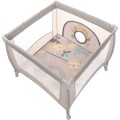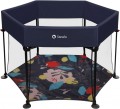Wall material
— Fabric. Dense fabric protects the baby inside the playpen from accidental drafts; in addition, it is safe when falling — the kid will not hurt himself/herself by falling on a soft wall. On the other hand, the fabric is opaque, and you can see the kid only by looking into the playpen from above. This is not very convenient, because completely
fabric playpens are practically never found.
—
Mesh. These playpens feature walls crafted from a fine mesh. The transparency eliminates the need to peer from above, allowing easy observation of the baby. The softness of the mesh ensures safety if the baby happens to fall against the walls. However, it is essential to note that the mesh might be less effective in shielding against accidental drafts, requiring careful consideration when choosing the playpen's placement.
— Fabric/mesh. Such models combine two materials: the end walls are most often made of fabric, and the sidewalls can be either entirely mesh or fabric with windows made in them. In such a playpen, the kid is better protected from drafts than in a mesh; at the same time, the walls allow you to see the child without looking from above, and it's ok to fall on them.
—
Plastic. Walls made of coloured plastic. They can be both solid and in the form of slats; in the latter case, the child can use them as a support to get to his/her feet. Some mo
...dels combine both options. The disadvantage of plastic is hardness — falling on it is fraught with painful bruises, and therefore this material is used quite rarely, mainly in models with a plastic frame (refer to "Frame material").
— Wood. Wooden walls are usually made in the form of slats. On the other hand, they offer little protection against accidental drafts and a fall on such a wall can be quite painful. This variant is used in models with a wooden frame; for the characteristics of wood, see the corresponding subparagraph under "Frame material".
— Metal. Metal walls, like the wooden walls described above, are made in the form of slats and have all the characteristic features of such structures: the child is always visible, but is not protected from drafts. On the one hand, this material is much more durable than wood, but on the other hand, it is less pleasant to the touch: metal slats feel cold. In light of this, this option is not particularly widespread.
— PVC/fabric. A specific synthetic fabric type involves a polyester mesh with a PVC coating. This material is applied to foam frames in some dry pools for protective purposes (refer to "Purpose"). The PVC coating can be either one-sided (external) or two-sided, with no significant difference. Playpens with PVC fabric have a smooth and slippery surface, safeguarding children from abrasions during play. This robust, durable, waterproof material withstands sunlight well and is easily cleaned from most contaminants.
— Vinyl leather. Synthetic material, which belongs to high quality leather substitutes. However, vinyl leather is one of the varieties of PVC-fabric described above and does not differ from it in its main properties and features and is used in the same way - as a cover for foam frames in dry pools.
— Vinyl. A dense polymer film used exclusively in inflatable dry pools (refer to "Purpose"). The properties and advantages of this material are described under "PVC/fabric" above. In fact, the pure vinyl differs from the polymer-fabric surface only in the absence of a fabric base — it is simply not required in this case.
For dry pools in this case, it is usually specified the material of the shell, which covers the walls - this material is what the child comes into contact with (inside such a shell is a foam rubber frame, for more details see "Frame Material").More features
—
Side entrance. An opening in the side or end wall of the playpen. Through such an entrance it is more convenient to put the baby inside — he or she does not have to be carried over a high wall, which can be quite tiresome with a grown-up child. In addition, if the situation allows, this entrance can be left open at all, giving the baby the opportunity to enter the playpen and get out of it at will.
—
Lockable wheels. There is a special lock on the wheels of the playpen. This playpen on wheels is convenient to move within the apartment, and putting in the desired place, you can lock the wheels — so the structure will not move from an accidental push (because of which the child inside could fall).
—
Toy pocket. A special pocket on the wall of the playpen that can be used to store toys, so that you always have them on hand to keep your child entertained. The pocket is often removable and in some models it can be combined with a changing table (refer to "Changing table").
—
Parent organizer. A special shelf with storage compartments on the side wall of the playpen. On such a shelf it is convenient to store various accessories — diapers, creams, powders, etc.
—
Mosquito net. This net can completely cover the playpen, protecting the baby inside from mosquitoes and other
...annoying and sometimes even dangerous insects. This feature will be useful especially for those who plan to use the playpen outdoors in the warm season.
— Transport bag. The playpen comes with a special bag. It makes transportation much easier. It is usually included with foldable playpens (see "Type").
— Music box. This is a MP3 player built into the playpen with an external speaker for playing music. This can be either fun tunes to entertain your kid during playtime or lullabies if the playpen is also used as a crib (for more information see "Mattress haight adjustment"). The set of melodies can be preset or downloaded at your request.
— Vibration block. A rocking mechanism for the playpen. This function is not necessary when the structure is used for its intended purpose, but it is useful if the playpen is used as a crib — rocking will help to lull the baby to sleep.
— Night light. A light that can be left on at night if the kid is afraid to fall asleep in total darkness. For example, if you need to get something from the nursery, but the kid is already asleep and it is undesirable to turn on the common light. A night light is not needed when the baby is awake, so this function is only found in playpen cribs (refer to "Purpose").
— Handles for the baby. Special handles inside the playpen to make it easier for the baby to stand up and walk. This function is especially important for playpens with fabric and/or net walls — without them, the only support for the baby will be the upper part of the walls.
— Arc with toys. An arc with toys placed above the playpen. It is intended primarily for babies when the playpen is used as a crib — the toys can distract the baby to stop crying, for example. The arc can also be used for playing at an older age, but it is less suitable for this purpose — the toys are located quite high and it is difficult to reach them.
— Canopy. The playpen has a canopy that partially covers the area around the head of the child lying down, similar to the way it is done in strollers for babies. In fact, the canopy is mainly used in playpen cribs (refer to "Purpose"). It provides additional protection from sunlight and other light that can disturb a sleeping baby, and can also play the role of a arc with toys (see above).
— Balls. The balls are used as a filler for dry pools (refer to "Purpose") and can be included with them. Balls can be bought separately, but it is more convenient to buy a dry pool with balls at once — especially since such a set will have the right amount of them.Max. weight
Weight, which is not recommended by the manufacturer to exceed. Naturally, nothing terrible will happen if the playpen is overloaded. However, if you regularly give an excessive load, then in the end it will lead to breakdown. So most of them are designed for a weight of 15 kg, which corresponds to a three-year-old child.

